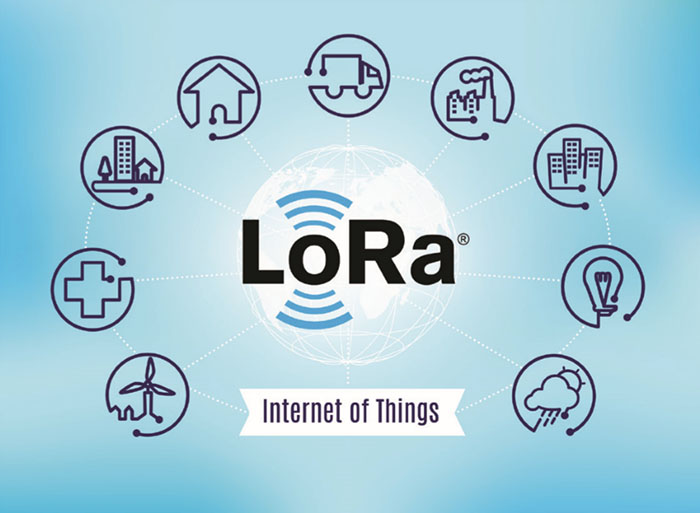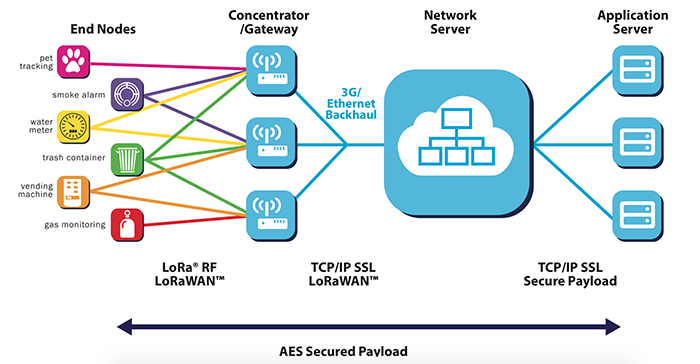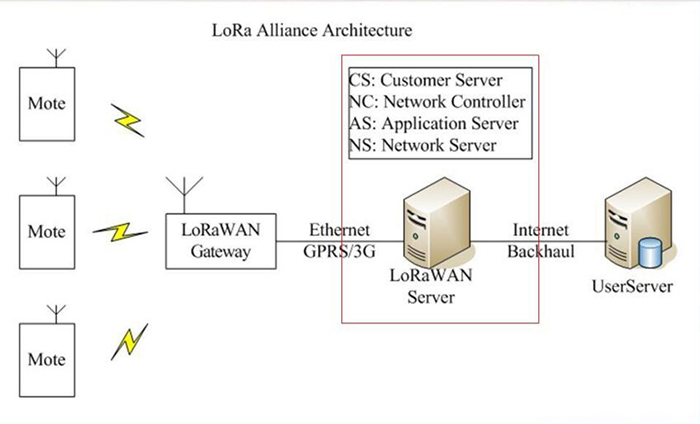As the Internet of Things (IoT) technology has attracted great attention in recent years, many familiar technologies and related promotions such as Narrowband Internet of Things (NB-IoT), LTE-M (Long Term Evolution, Category M1), Wi-SUN and Sigfox have Alliances compete in the market, and LoRa technology has a lot of deployment and attention around the world.


1. What is LoRa?
LPWAN (low-power Wide-Area Network, low-power wide area network) is designed for IoT applications with low bandwidth, low power consumption, long distance, and a large number of connections. LoRa already has a more mature ecological chain and a faster pace of commercialization , is expected to maintain a exponential growth rate in the next few years.
Wireless technologies in IoT applications are mainly divided into two types. One is short-range wireless technology, such as Bluetooth/WiFi/ZigBee. The other is the technology that makes up the wide area network, such as 2G/3G/4G. The advantages and disadvantages of each technology are very obvious. Before the emergence of LPWAN technology, usually only one could be chosen between long distance and low power consumption. After the emergence of LPWAN technology, the problem of fish and bear’s paw can be said to be balanced. In addition to achieving longer distance communication and ultra-low power consumption, it can also save additional repeater costs.
LoRa is a very representative technology in LPWAN communication technology. It is an ultra-long-distance wireless transmission solution based on spread spectrum technology adopted and promoted by the American Semtech company. This transmission solution changes the previous trade-off considerations between transmission distance and power consumption. method, providing a simple system that can achieve long distance, long battery life, and large capacity, thereby expanding the sensor network. Currently, LoRa mainly operates in free frequency bands around the world, including 433, 868, 915MHz, etc.
2. What are the advantages and characteristics of LoRa?
1. Improved reception sensitivity and reduced power consumption.
The link budget of up to 157db enables the communication distance to be up to 15 kilometers (depending on the environment). Its receiving current is only 10mA and its sleep current is 200nA, which greatly delays the battery life.
2. The gateway/concentrator based on this technology supports parallel processing of multiple channels and multiple data rates, and the system capacity is large.
The gateway is the bridge between the node and the IP network (through 2G/3G/4G or Ethernet). Each gateway can handle 5 million communications between nodes per day (assuming 10 Bytes are sent each time and the network occupancy is 10%). If the gateway is installed at the location of an existing mobile communication base station with a transmitting power of 20dBm (100mW), it can cover about 2 kilometers in a densely built urban environment, and in lower-density suburbs, the coverage can reach 10 kilometers.
3. Systems based on terminals and concentrators/gateways can support ranging and positioning.
LoRa’s distance measurement is based on the air transmission time of the signal rather than the traditional RSSI (Received Signal Sterngth Ind-ication), while positioning is based on the measurement of the air transmission time difference between multiple points (gateways) and one point (node). Its positioning accuracy can reach 5m (assuming a range of 10km).
3. What is the networking architecture of LoRa?
The LoRa network mainly consists of terminals (can have built-in LoRa modules ), gateways (or base stations), network servers and application servers. Its network architecture is a typical star topology. In this network architecture, the LoRa gateway is a transparent transmission relay that connects the terminal device and the back-end central server. End devices communicate with one or more gateways using a single hop. There is two-way communication between all nodes and the gateway.


The terminal nodes of LoRa may be various devices, such as water and gas meters, smoke alarms, pet trackers, etc. These nodes are first connected to the LoRa gateway through LoRa wireless communication, and then connected to the network server through the 3G network or Ethernet network. The gateway and network server communicate through TCP/IP protocol.
LoRa terminal equipment
The terminal nodes of LoRa may be various devices, such as water and gas meters, smoke alarms, pet trackers, etc. These nodes are first connected to the LoRa gateway through LoRa wireless communication, and then connected to the network server through the 3G network or Ethernet network. The gateway and network server communicate through TCP/IP protocol.
The LoRa network divides terminal devices into three categories: A/B/C:
Class A: Two-way communication terminal equipment. This type of terminal device allows two-way communication, and each terminal device’s upstream transmission is accompanied by two downstream reception windows. The transmission time slot of the terminal device is based on its own communication needs, and its fine-tuning is based on the ALOHA protocol.


Class A equipment has the lowest power consumption, and the downlink communication of the base station can only occur after the uplink communication of the terminal.
Class B: Two-way communication terminal equipment with preset reception time slots. This type of terminal equipment will open redundant receiving windows during the preset time. To achieve this purpose, the terminal equipment will receive a Beacon from the gateway synchronously, and synchronize the time of the base station and the module through the Beacon.


Class B terminals can let the base station know that the terminal is receiving data
Class C: Two-way communication terminal equipment with maximum receive window. Terminal devices of this type keep the receive window open and only close it during transmission.


Class C devices have the longest reception window and consume the most power
4. LoRa application scenarios
Networks based on LoRaWAN can provide secure two-way communication over long distances and cover urban areas with minimal network infrastructure. LoRa will be widely used in various application scenarios such as smart agriculture, smart buildings, and smart logistics.


1. Smart agriculture
For agriculture, low-power and low-cost sensors are urgently needed. The application of sensors such as temperature and humidity, carbon dioxide, and salinity is of great significance to agriculture in increasing production and reducing water consumption. However, these data indicators will not change significantly in a short period of time, and the data volume is small and requires real-time performance. Not high, so LoRa is undoubtedly the best choice.
2. Smart buildings
For the renovation of buildings, sensors such as temperature and humidity, safety, harmful gas, and water flow monitoring are added and the monitoring information is uploaded regularly, which facilitates the supervision of managers and makes it more convenient for users. Generally speaking, the communication of these sensors does not need to be particularly frequent or to ensure particularly good service quality. At the same time, a portable home gateway can meet the needs, so LoRa is a more suitable choice in this scenario.
3. Automated manufacturing
In the automated industrial production environment, a large number of intelligent technologies are applied, and various information data are exchanged in the network. Therefore, the characteristics of the selected network are directly related to the execution quality of the production plan. Some scenarios require low-cost sensors with low power consumption and long-life batteries to track equipment and monitor status. In this case, LoRa is a reasonable choice.
4. Smart logistics
The logistics industry covers a very broad geographical area, so when choosing a network, the first considerations are low investment and long working life. In order to be able to track pallets and determine the location and status of goods, freight companies need all the facilities involved in the entire logistics process to be covered by the network. This not only requires the network nodes to be economical enough to facilitate large-scale deployment, but also to have mobility to make them Can be installed on transport vehicles as a mobile gateway. In this way, NB-IoT technology that relies on 4G base station network obviously cannot meet this requirement. LoRa’s low cost, high battery life, high mobility, and communication stability during high-speed movement make it unique in the field of smart logistics. Lead the way.
In the new wave of development of the Internet of Things, in the field of low-power wide-area networks, in the context of large-scale deployment and application in developed markets, domestic participants are also using open wisdom to promote the large-scale deployment and deployment of LoRa networks in the country. Application, I believe that with the increase in industry applications, this domestic operator-level LoRa network formed based on the concept of sharing economy will also become the core area of the global LoRa layout.
At present, the world’s two mainstream IoT networks, NB-IoT and LoRa, are developing rapidly in China. According to relevant departments, more than a thousand IoT application products have been launched in various provinces in China. It is reported that 70% of companies are actively seeking mature, reliable and quickly implemented IoT products. Most companies purchase NB-IoT and LoRa IoT solutions from Fuzhou Xiecheng Intelligent Technology Co., Ltd., including LoRa gateways, smoke sensors, water It has dozens of IoT products such as monitoring, infrared detection, positioning, and power strips. It also develops NB-IoT and LoRa IoT products on behalf of others in order to quickly develop IoT business and become the leader in IoT in cities across the country. The situation of “Looking at China for the development of the world’s Internet of Things” is gradually taking shape.
Résumer
Low Power Wide Area Network (LPWAN) is an indispensable part of the Internet of Things. It has flexible and scalable characteristics and can be large or small. This is required in the growth and exploration stage of the Internet of Things industry. It can It is said to be the most suitable technology for the Internet of Things. LoRa is safe and reliable, with features such as two-way authentication, end-to-end encryption and integrity protection. It is comprehensive and forward-looking in terms of security design. However, IoT security cannot be ignored and requires the industry’s joint efforts to continue to promote it.
